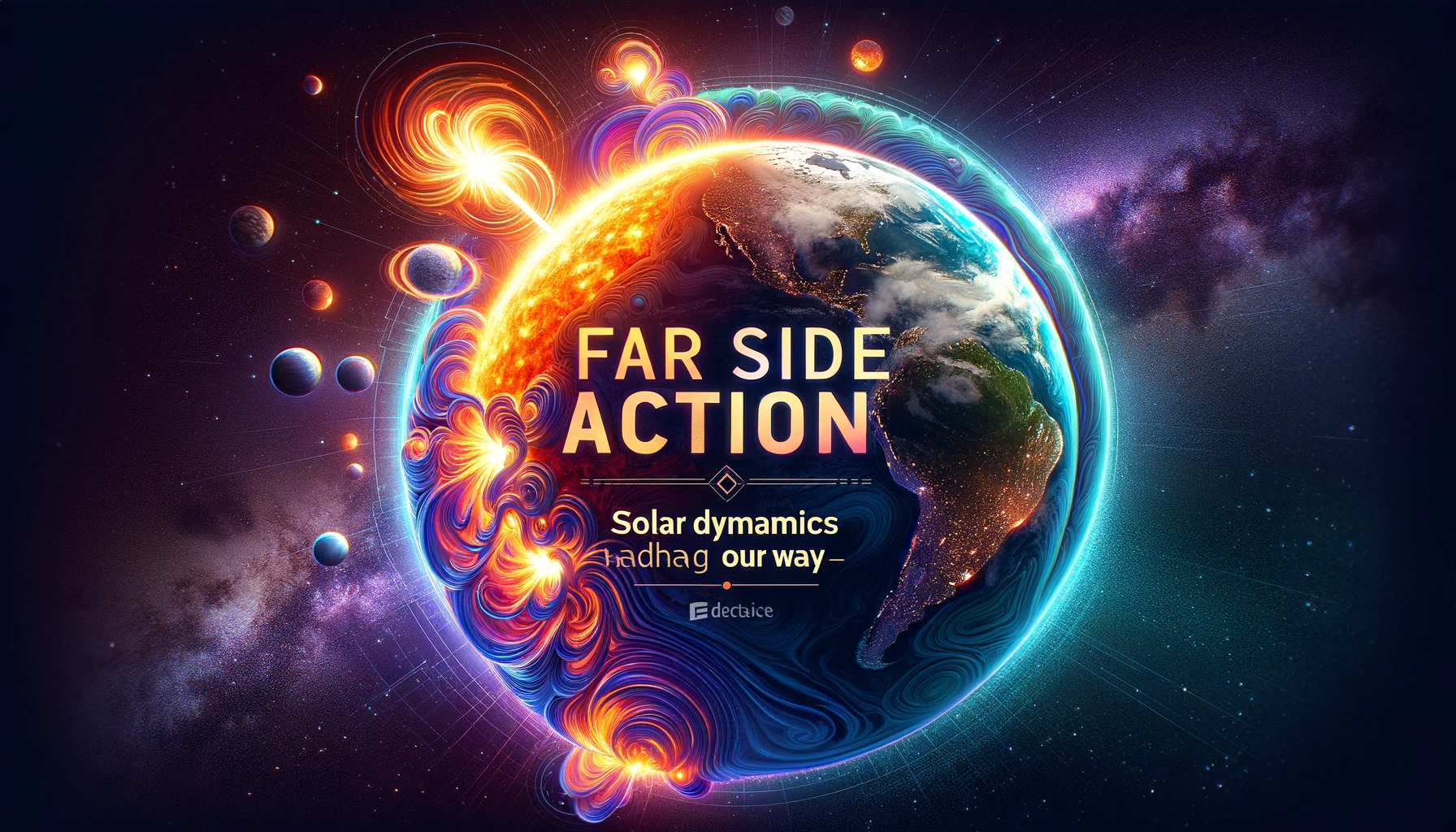Client Pro Blogs
Get Unlimited Leads With 'AI'
Download Our Free Ebook

Sun activity: Far Side Action Could Head Our Way
Introduction
The sun, our closest star, is a dynamic entity whose activities have a profound impact on the solar system, especially Earth. Understanding the intricacies of solar activity, particularly events on the far side that could eventually influence our planet, is crucial for preparing for potential space weather effects. This article, tailored for college-level readers, will delve into the nature of solar activity, the significance of far side solar events, and the mechanisms by which these events can affect Earth.

The Intricate Nature of Solar Activity
Solar activity, the dynamic behavior of our sun, is a captivating and intricate phenomenon that has fascinated scientists for centuries. At the heart of this celestial spectacle lies a complex interplay of various processes that influence the sun's behavior.
One of the most prominent features of solar activity is the sunspot cycle, which occurs roughly every 11 years and involves the waxing and waning of dark spots on the sun's surface. These sunspots are associated with magnetic activity and can impact our own planet, causing phenomena like solar flares and geomagnetic storms.
Solar activity is driven by the sun's internal processes, primarily the convective motion of hot plasma within its core. This motion generates magnetic fields that become twisted and tangled over time, leading to the formation of sunspots and the release of energy in the form of solar radiation. Understanding these intricate processes is crucial, as they can have profound effects on Earth's climate, communication systems, and even power grids.
Sunspots and the Far Side of the Sun
Sunspots, intriguing features on the sun's surface, play a pivotal role in our understanding of solar activity. These cooler, darker regions, formed by intense magnetic activity, serve as indicators of the sun's magnetic field fluctuations.
While monitoring sunspots on the Earth-facing side is relatively straightforward, observing those on the sun's far side presents a significant challenge. This is primarily due to the sun's spherical nature, which keeps its far side perpetually out of direct view from Earth.
However, understanding the activity on the far side is crucial. The sun rotates approximately every 27 days, meaning active regions, including sunspots, on the far side can eventually rotate into Earth's view.
These sunspots could be harbingers of potential solar flares or coronal mass ejections, which, if directed towards Earth, could significantly impact space weather and, consequently, our technological systems. Therefore, monitoring and understanding these far side sunspots are not just a matter of scientific curiosity, but a necessity for predicting and preparing for space weather phenomena that could affect Earth.
Far Side Monitoring Techniques
Monitoring the far side of the sun, an area not directly visible from Earth, is a challenging yet crucial aspect of understanding solar activity. To overcome this challenge, astronomers and scientists employ innovative techniques.
One such method is helioseismic holography, a technique that utilizes the sun's acoustic waves. These waves, generated by turbulent motions beneath the sun's surface, travel through the solar interior and carry information about the far side's activities. By analyzing these waves, scientists can infer the presence of sunspots and other magnetic activities on the sun's hidden half.

Another significant method involves the strategic positioning of spacecraft. Satellites such as the Solar and Heliospheric Observatory (SOHO) and the Solar Terrestrial Relations Observatory (STEREO) are placed in orbits that allow them to capture images and data from the sun's far side. These spacecraft relay valuable information back to Earth, providing a more comprehensive view of the sun's behavior.

This approach not only helps in predicting potential solar storms that might impact Earth after the sun's rotation brings them into view but also enhances our overall understanding of solar dynamics. These far side monitoring techniques are integral to our preparedness for space weather and our ongoing exploration of solar phenomena.
Solar Flares: The Powerhouses of Solar Phenomena
Solar flares stand as one of the most energetic and intriguing phenomena within our solar system. Originating from the sun, these are intense bursts of radiation that are awe-inspiring both in their power and their potential impact on Earth. These flares occur when magnetic energy that has built up in the solar atmosphere is suddenly released. Radiating across the electromagnetic spectrum, solar flares emit energy that can be equivalent to millions of 100-megaton hydrogen bombs exploding at the same time.
These flares are classified into three categories: C-class (small), M-class (medium), and the most powerful, X-class. While the smaller flares are often unnoticed on Earth, the larger ones, particularly the X-class, can have profound effects, including disrupting satellite communications and power grids.
What makes solar flares particularly fascinating is their unpredictability and the rapidity with which they can unleash such vast amounts of energy, a subject of continuous study and marvel in astrophysics. Understanding these solar events is not just an academic pursuit but a practical necessity, as our increasingly technology-dependent society becomes more vulnerable to their impacts.
Coronal Mass Ejections and their Journey to Earth
Coronal Mass Ejections (CMEs), significant phenomena in solar dynamics, are vast expulsions of plasma and magnetic fields from the Sun's outer atmosphere, the corona. Originating from areas of strong magnetic activity, often associated with sunspots and solar flares, CMEs propel billions of tons of coronal material into space at speeds ranging from 250 to over 3,000 kilometers per second.
As these colossal clouds of charged particles journey through space, their interaction with Earth's magnetosphere becomes a focal point for scientists. Upon reaching Earth, which typically takes one to five days depending on their speed, CMEs can trigger geomagnetic storms. These storms have the potential to disrupt satellite operations, telecommunications, and power grids.
However, not all CMEs impact Earth; their direction and the interplanetary magnetic field's orientation are critical factors.
The study and monitoring of CMEs are crucial for anticipating space weather events, safeguarding technological systems, and understanding the Sun-Earth connection in greater detail. This intricate interplay between the Sun's explosive activities and our planet's magnetic shield underlines the importance of advanced observation and forecasting in space weather science.
Impact on Earth and Technological Systems
The impact of solar activity on Earth and our technological systems is both fascinating and significant, warranting close attention. When intense solar events like flares and coronal mass ejections (CMEs) reach our planet, they interact with Earth's magnetosphere, leading to various effects. This interaction can result in stunning natural displays like the auroras, commonly known as the Northern and Southern Lights. However, the consequences can also extend to more disruptive outcomes, particularly for our technological infrastructure.
For instance, geomagnetic storms induced by these solar events can disrupt satellite operations, affecting communication and GPS navigation. More critically, they can cause fluctuations in power grids, potentially leading to widespread power outages. Additionally, these solar phenomena can pose risks to astronauts in space by increasing the levels of harmful solar radiation.
Understanding and forecasting these solar activities is essential for mitigating their impact, especially in our increasingly technology-dependent world. This knowledge not only aids in protecting vital satellite and communication networks but also ensures the safety and efficiency of space exploration endeavors.
Preparing for Solar Activity: The Role of Forecasting
The ability to forecast solar activity is not just a scientific pursuit; it's a necessary defense against the potentially disruptive impacts of our sun's temperamental behavior. This task, daunting yet crucial, is undertaken by specialized agencies worldwide, such as NOAA's Space Weather Prediction Center.
These organizations employ an array of sophisticated instruments and techniques, including satellite imagery and helioseismic data, to monitor the sun's activity. Their objective is to detect and predict phenomena like solar flares and coronal mass ejections (CMEs), particularly those originating from the sun's far side that could rotate into Earth's path.
Accurate forecasting is vital for several reasons. It ensures the safety of astronauts in space, who are vulnerable to increased radiation during solar events. On Earth, it helps in protecting intricate and vital technological systems - from satellite communications, which play a crucial role in our daily lives, to power grids that sustain modern society. Thus, the role of forecasting in preparing for solar activity is a testament to our growing understanding of the sun's influence and our relentless pursuit of resilience against space weather.
Conclusion: Embracing Solar Awareness
In conclusion, while the far side of the sun remains largely hidden from direct view, our growing understanding of solar dynamics and improved monitoring techniques allow us to anticipate and prepare for the effects of solar activity. As we continue to study our star, we not only gain insights into the workings of our own solar system but also enhance our ability to protect our technological infrastructure from the far-reaching influence of the sun.
Embracing solar awareness is not only a responsible choice for individuals and communities but also a crucial step towards a sustainable future. Solar energy offers a plethora of benefits, ranging from reducing our carbon footprint to saving on energy costs. By harnessing the power of the sun, we can significantly decrease our reliance on fossil fuels, which are not only finite resources but also major contributors to climate change. Moreover, solar panels have become more accessible and affordable than ever, making it easier for homeowners and businesses to adopt this clean energy source.
Furthermore, embracing solar awareness can also stimulate economic growth by creating jobs in the renewable energy sector and promoting technological innovation. It is essential that we promote solar education and advocate for policies that support the expansion of solar energy infrastructure. By doing so, we can pave the way for a more sustainable and environmentally friendly future while reaping the economic and environmental benefits of solar energy. So, let's embrace solar awareness and take a step towards a cleaner, greener tomorrow.
Let’s get you growing. Without the growing pains.
Let’s get you growing. Without the growing pains.
Contact Us
Easily Integrates With Leading Apps





About Client Pro
Culture
Compare Client Pro
Customer stories
Products
Features
All features
Appointments
Automation
CRM
Ecommerce & payments
Email marketing
Integrations
Landing pages & forms
Lead management
Reporting & analytics
Sales pipeline
Text marketing
Resources
Events
What is a CRM?
Lifecycle Automation
LCA Assessment
Free email templates
Subject Line Generator
How-to guides
Blog
Partners
Find a partner!
Apps & integrations
Help & Support
New customer resources
Customer Support
Help center!
Training Academy
Client Pro Marketplace
Play & template library!
Culture
Compare ClientPro
Customer stories
Contact us
Features
All features
Appointments
Automation
CRM
Email marketing
Text marketing
Sales Pipeline
Integrations
Payments & Invoicing
Websties & Landing pages
Lead management
Reporting & analytics
Products
Basic
Pro
AI Agent
Resources
Events
Automation
Free email templates
How-to guides
Blog
Help & Support
Customer Support
Help center
Client Pro Training Academy
Marketplace
Data migration
Coaching & guarantee
Product updates
Partners
Become a partner
Partner portal
Apps & integrations



